Direct-flush toilet - design features and installation
It is necessary to approach the choice of a toilet bowl with mind, it is necessary to consider not only its appearance, but also design features. In particular, you need to pay attention to the type of release, this parameter is especially important when replacing a sanitary fixture - an incorrectly chosen type can create many problems during installation and operation.
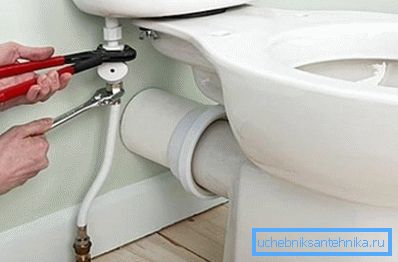
Types of toilet sink
When it comes to the type of release or the type of discharge, it means how the disposal of human waste products is organized.
There are 3 options:
- a toilet with a direct exit - in this case the exit is parallel to the floor. It is this plum that is most often found in new buildings;
- the slanting exit is arranged at an angle of 30-45 ?;
Note! Sanitary devices with direct and oblique exit will not be able to be installed close to the wall of the toilet. If the house is built from scratch, then you should think about the devices with a vertical exit.
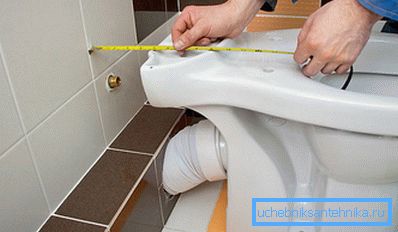
- vertical exit can be arranged in private homes. This type of drainage is typical for houses of the 1st half of the last century.
If we compare the listed types of outputs, then it can be noted that the straight and oblique versions require a little more space for installation. But if necessary, instead of a sanitary fixture with direct output, you can always install an analogue, but with an oblique drain. To do this, you will only need to replace the tee on the sewer riser and adjust the height of the sanitary equipment.

In addition, the classification can be given by the design of the bowl. For example, a toilet bowl is equipped with a shelf for splash protection, and funnel-shaped provide for the release of waste products directly into the water.
But with a vertical discharge, this number will not work. Nevertheless, to put the question in the form of which issue of the toilet bowl is better than a straight or oblique is not entirely correct - it all depends on local conditions. For example, when replacing a sanitary fixture with an oblique sink, it is not advisable to buy a sanitary fixture with a vertical drain; it will be quite difficult to install.
Installation Methods
The installation consists of 2 stages - the actual installation of the case and its attachment to the floor, as well as its connection to the riser. And if there shouldn't be any special issues with mounting to the floor, then here are a few options with connecting a sanitary device, but in any case, all the work can be done with your own hands.
Use of sewer corrugations
Special sewage corrugation allows you to connect, even in conditions of lack of free space. Externally, the corrugation looks like a ribbed stretch pipe made of plastic, with its help you can connect the toilet with both direct and oblique release.
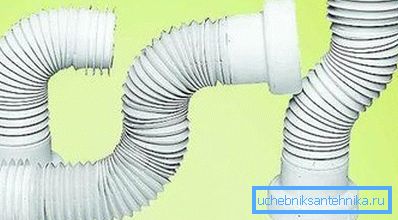
Installation of sanitary equipment is performed in the following sequence:
- first pretends its placement in the toilet, marks the position of the hole in the floor under the mount;
- then the sanitary fixture is put in place and the dowels are inserted into the drilled holes;
- then the corrugation is put on the release of the toilet bowl, while it is necessary, the corrugation is approaching about 5-6 cm;

Note! When you connect the toilet with a direct release (and with other types of drain) you need to pay special attention to the tightness of the connections. When using a corrugation, it is desirable to use a silicone sealant, there will definitely be no harm from this.
- then the second end of the corrugation can be inserted into the pipe, for the tightness of the connection is used all the same sealant. The connection is considered complete, the last thing left to do is connect the drain tank.

Note! Sealant must necessarily be between the surfaces of the corrugations and the release. If you try to coat them with the joint after the connection, then there will be no benefit.
The last thing to do is check the tightness of the joints. To do this, it is enough to pour a bucket of water into the toilet and watch the joints - do they not leak and finally install the plumbing fixture on the tile with a mandatory sealing of the installation site with a sealant.
Connecting models with a slanting release without corrugations
Let's find out when a particular toilet is selected - an oblique outlet or a direct one does not always have the opportunity to choose, because you have to adjust to the existing sewer layout in the apartment. Sometimes you have to dwell on models with oblique discharge.
If the axis of the outlet and the sewer pipe are in the same plane or not strongly displaced relative to each other, then you can do without a fairly fragile corrugations. In this case, you will need a plastic adapter and a rubber cuff (optional) to connect the plumbing fixture; a toilet adapter with a direct outlet is used for the same purpose.
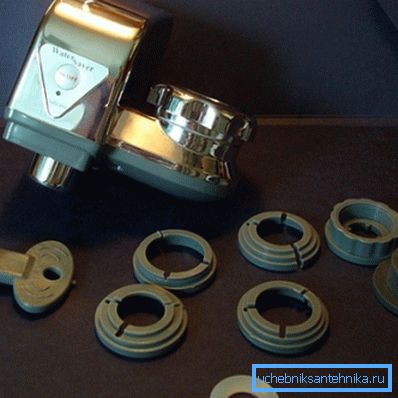
The main task during installation is to achieve the closest possible location of the sanitary equipment to the back wall of the toilet. Of course, this should not affect the stock. Ideally, the exit from the plumbing device is connected directly to the tee on the riser.
The connection itself is quite simple - with the help of an adapter, the release of the toilet bowl is simply connected to the sewer pipe, and the joints are sealed. If the holes are offset from each other, then an eccentric rubber sleeve can be used.
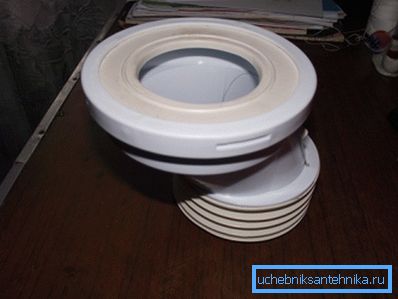
Note! It is undesirable to stretch a corrugated pipe, its wall is thin enough and can be easily torn. Its price is not so great, so it’s better not to save on length.
As for tightness, it is achieved in the following way:
- preparing a solution of red lead and linseed oil, they release the release from the toilet bowl;
- on top there is a winding of tarred tow, after winding the tow is additionally soaked with the prepared mixture;
Note! The edge of the exit (1-2 cm) should be free from winding, so that nothing interferes with the flow of water flow.
- then the outlet is simply put on the socket of the adapter or the outlet is inserted into the socket of the sewer pipe.
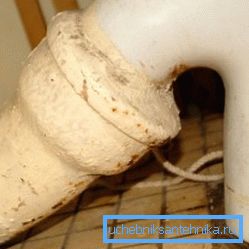
Not everyone has at hand a minium and linseed oil, so you can do without the steps listed, but simply use rubber cuffs and sealant to ensure tightness.
Installing a toilet bowl with a direct release with their own hands is considered the easiest. All you need is an adapter, sealant and rubber seal. To connect it is enough to connect an adapter with an outlet and a tee on a riser. Instead of a plastic adapter, it is quite possible to do with a corrugation.
Vertical outlet
In this case, the drain is carried out in a pipe located in the floor. Corrugated pipe and adapters in this case will not be needed - the issue will be connected directly to the sewer pipe.
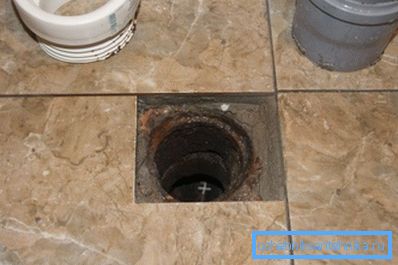
If the installation of a toilet with a direct release involves the use of adapters or corrugated pipes, then to connect the sanitary equipment with a vertical drain will need only a screw flange.
The work is performed in the following sequence:
- a screw flange fitted with a retainer is installed on the pipe in the floor;
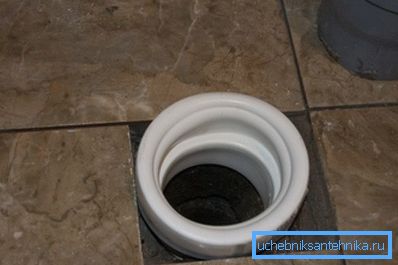
- after that the base is prepared - holes for fastenings are drilled;
- The toilet is installed on the floor, and its release is inserted into the flange and is very tightly pressed to the pipe. Additional sealing provides a rubber ring and sealant.
In conclusion
On the installation and connection of the toilet affects the selected type of drain. However, the work is not difficult and even a plumber novice can handle it, it’s enough just to stick to the suggested tips.
The video in this article shows an example of installing a toilet with a vertical drain.